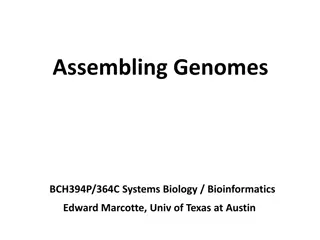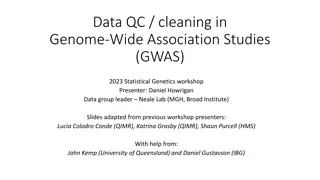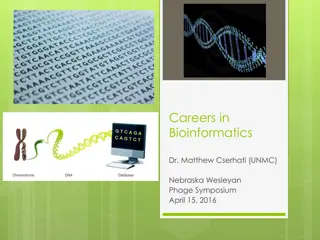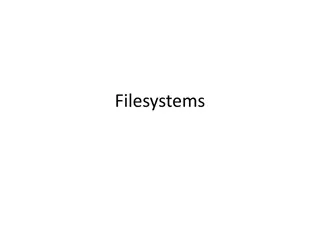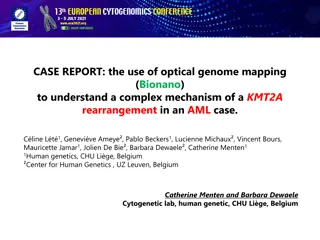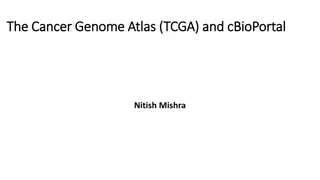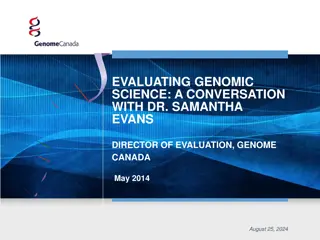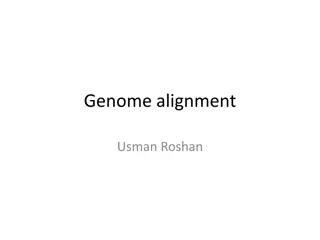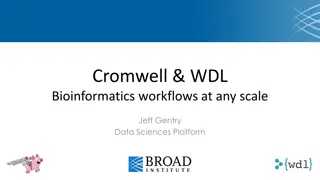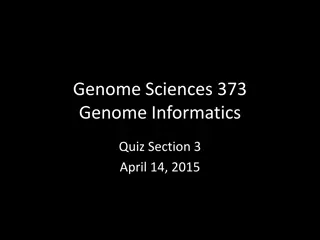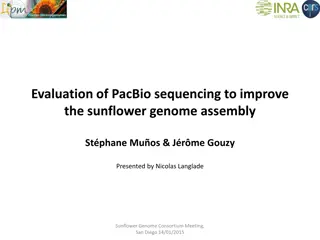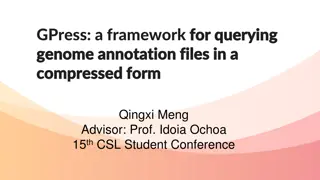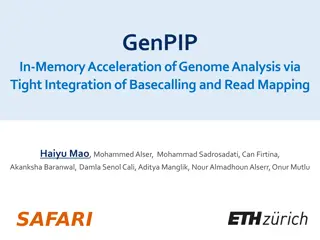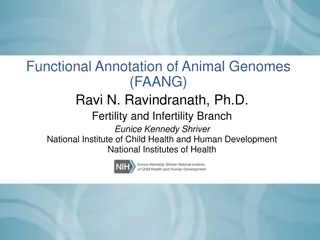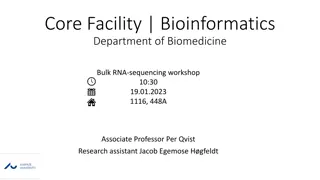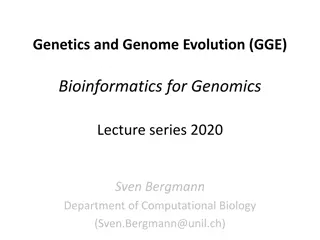Efficient Ways to Download Genome Files for Bioinformatics Analysis
Obtain valuable insights into retrieving genome files for bioinformatics analysis utilizing multiple methods such as connecting via Finder, using Filezilla for FTP access, and executing curl commands on Xanadu. Learn how to access coding sequences, feature tables, nucleotide sequences, and encoded proteins for an in-depth genomic study.
Download Presentation

Please find below an Image/Link to download the presentation.
The content on the website is provided AS IS for your information and personal use only. It may not be sold, licensed, or shared on other websites without obtaining consent from the author.If you encounter any issues during the download, it is possible that the publisher has removed the file from their server.
You are allowed to download the files provided on this website for personal or commercial use, subject to the condition that they are used lawfully. All files are the property of their respective owners.
The content on the website is provided AS IS for your information and personal use only. It may not be sold, licensed, or shared on other websites without obtaining consent from the author.
E N D
Presentation Transcript
MCB 3421 class 11 Gene plots Origin of replication Strand bias cumulative GC skew Architecture imparting sequences
A. hydophila WCHAH045096 Aeromonas veronii HM21
Aeromonas simiae A6 Aeromonas veronii HM21
Many genomes are available at the NCBI https://www.ncbi.nlm.nih.gov/genome/browse#!/overview/
You can open the link in finder, or an FTP program (use guest) All coding sequences Genome feature table The nucleotide sequence All encoded proteins
There are different ways to down load the files: A) via the finder (under OS X) B) Using Filezilla: Connect to ftp.ncbi.nlm.nih.gov login type anonymous. Then copy the R link (right click) from the microbial browser and paste it into the address field delete everything before genome: C) ssh to Xanadu, go to a compute node, and the use the copy url command. To get the address, copy the R link (right click) to the clipboard, paste it behind curl -O E.g., curl -O ftp://ftp.ncbi.nlm.nih.gov/genomes/all/GCF/002/850/695/GCF_002850695.3_ASM285069v3/ Then complete the line with GCF_002850695.3_ASM285069v3_protein.faa.gz (for all the encoded proteins in a multiple fasta file GCF_002850695.3_ASM285069v3_genomic.fna.gz (for the nucleotide sequence of genome +plasmids GCF_002850695.3_ASM285069v3_feature_table.txt.gz (for the feature table) The commands to execute would be curl -O ftp://ftp.ncbi.nlm.nih.gov/genomes/all/GCF/002/850/695/GCF_002850695.3_ASM285069v3/GCF_002850695.3_ASM285069v3_protein.faa.gz curl -O ftp://ftp.ncbi.nlm.nih.gov/genomes/all/GCF/002/850/695/GCF_002850695.3_ASM285069v3/GCF_002850695.3_ASM285069v3_genomic.fna.gz curl -O ftp://ftp.ncbi.nlm.nih.gov/genomes/all/GCF/002/850/695/GCF_002850695.3_ASM285069v3/GCF_002850695.3_ASM285069v3_feature_table.txt.gz Once you have the files you need to uncompress them using gunzip GCF_002850695.3_ASM285069v3_protein.faa.gz or using a wild card gunzip *.gz
Comment on FTP and browsers: Comment on FTP and browsers: If you use Firefox, Safari or Chrome, the ftp:// in the address directs you to open the link in finder (and I have not found a way to disable this feature ). This is totally annoying, if you want to copy the url of a particular file to use curl to download it. At present waterfox (a slimmed down version of firefox) is working fine. If you click (left click) on the R-link, you get the following: You can right click on a file, copy the link and use it (via paste) in curl : curl O ftp://ftp.ncbi.nlm.nih.gov/genom es/all/GCF/000/464/515/GCF_00046 4515.2_ASM46451v2/GCF_000464515. 2_ASM46451v2_genomic.fna.gz (this is all on one line)
There are several different approaches to map a best scoring blast hits to a location in the genome. One approach is to link databank tables. A simple alternative is to reannotate the annotation lines so that they start with the location in the genome.
Top scoring hits only GI replaced with number
Aeromonas_hydrophila_ATCC_7966_uid58617 versus Aeromonas_hydrophila_ML09_119_uid205540/ Evalue cut off: 10^-4 To only plot the top scoring hits use extract_lines.pl -->
Aeromonas_hydrophila_ATCC_7966_uid58617 versus Aeromonas_hydrophila_ML09_119_uid205540/ E-value cut off: 10^-4 Top-scoring hits only
Same with Gnuplot Aeromonas_hydrophila_ATCC_7966_uid58617 versus Aeromonas_hydrophila_ML09_119_uid205540/
Aeromonas_hydrophila_ML09_119_uid205540 versus Aeromonas_salmonicida A449
Aeromonas_veronii B565 versus Aeromonas_hydrophila_ML09_119_uid205540
Two Reasons for Recombination Patterns in Microbial genomes: A) Recombination events occur at the time of replication Figure 2. Rearrangement of gene order by translocation of genes across the replication axis. A hypothetical ancestral gene order is indicated (left). After passage of the replication forks (triangles), genes C and D have exchanged positions with W and X by translocation across the replication axis (vertical dashed line) in the descendant genome. For simplicity, the diagram shows a reciprocal translocation that might occur in a single round of replication through two reciprocal recombination events. The diagram does not specify a mechanism for the translocation of genes, which may also occur in several steps as a series of recombination events in separate rounds of replication through intermediate genome organizations. The two replication forks are proposed to be across the replication axis and physically close together, promoting translocation of sequences at the forks. Numbers indicate the percentage of distance from the origin.
GCBias in a window (G-C/(G+C))
Cumulative GCSkew SUM(C-G) measured along the genome from the ORI
The same can be done with oligonucleotide bias (how often does an oligonucleotide occur on one strand minus occurrence on the other strand) Cumulative Tetramer bias for Thermus thermophilus SG0
Two Reasons for Recombination Patterns in Microbial genomes: A) Recombination events occur at the time of replication Figure 2. Rearrangement of gene order by translocation of genes across the replication axis. A hypothetical ancestral gene order is indicated (left). After passage of the replication forks (triangles), genes C and D have exchanged positions with W and X by translocation across the replication axis (vertical dashed line) in the descendant genome. For simplicity, the diagram shows a reciprocal translocation that might occur in a single round of replication through two reciprocal recombination events. The diagram does not specify a mechanism for the translocation of genes, which may also occur in several steps as a series of recombination events in separate rounds of replication through intermediate genome organizations. The two replication forks are proposed to be across the replication axis and physically close together, promoting translocation of sequences at the forks. Numbers indicate the percentage of distance from the origin.
Two Reasons for Recombination Patterns in Microbial genomes: B) Recombination events that do not occur in a symmetric fashion between the two arms result in misplaced Genome Architecture IMparting Sequences (AIMS) dnaA boxes one way signals for the replication fork, ter sites , tus binding
Selection for Chromosome Architecture in Bacteria
Food for thought- What might have happened here? Aeromonas salmonicida S68 Aeromonas veronii HM21
Food for thought- What might have happened here? Aeromonas salmonicida O23A Aeromonas veronii HM21



